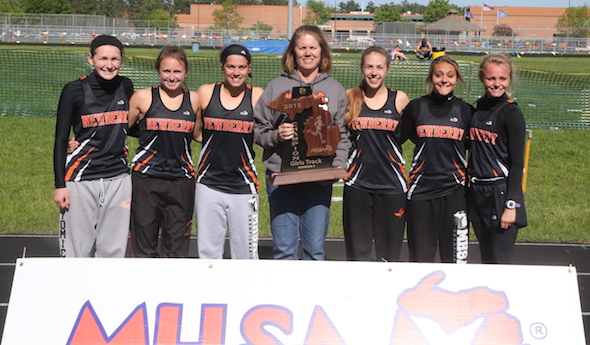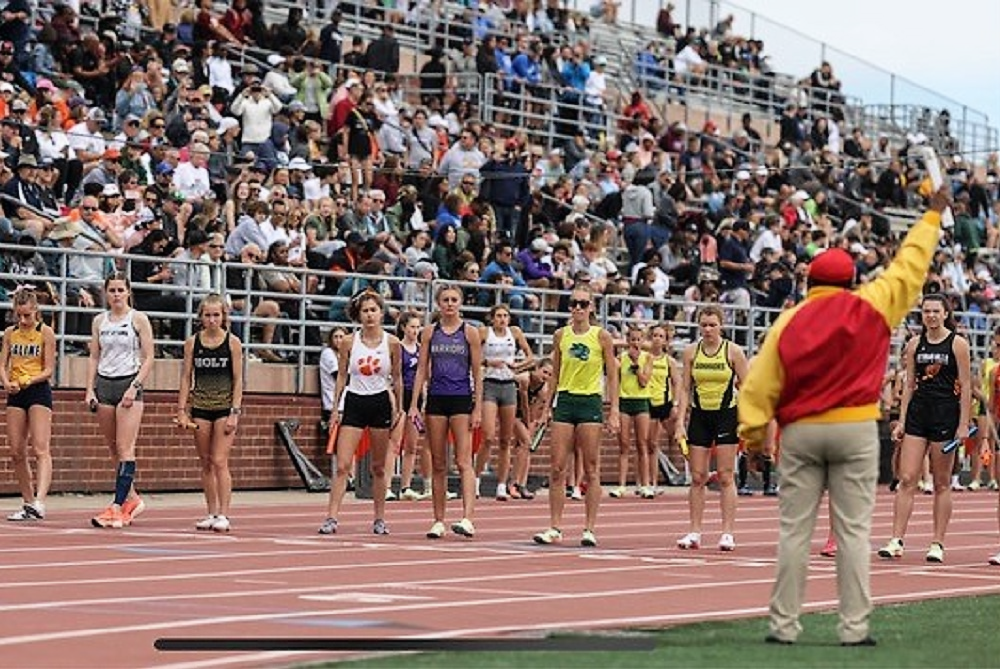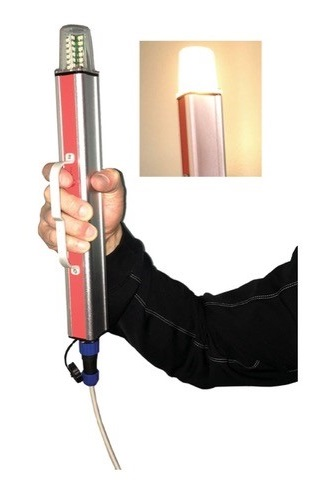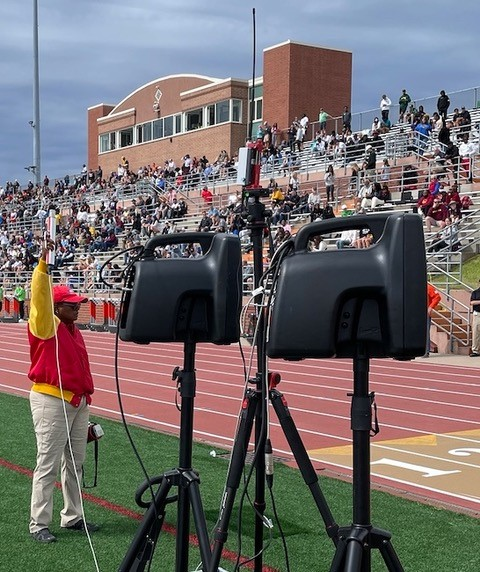
Newberry Claims Close Race in UPD3
By
John Vrancic
Special for MHSAA.com
May 31, 2015
KINGSFORD — Prior to Saturday, the Newberry girls track program had gone 24 years without an Upper Peninsula championship.
The Indians, competing in Class C at that time, ended that drought by edging Brimley 64-58 for their first Division 3 title. Ontonagon and Lake Linden-Hubbell tied for third with 48 points apiece.
Newberry junior Natalie Beaulieu won the 800-meter run in a school-record 2 minutes, 26.63 seconds and the 1,600 (5:23.45), and was runner-up in the 3,200 (12:09.09).
“I gave it my all in the 800 and 1,600,” said Beaulieu, who won the U.P. Division 2 title in the 3,200 last year. “I really focused on those races. When I heard that I had a 1:10 in the first lap of the 800, I felt I had a chance. I was really tired in the 3,200. It still went okay, but I didn’t have much left. I’m happy overall.”
Newberry’s Taylor Bryant won the 100 in 13.6 seconds, edging Stephenson’s Haley Truitt by one hundredth of a second, and placed fourth in the 300 hurdles (50.04). Bridget Stoetzer took second in the 400 (1:03.42) and fifth in the 800 (2:34.67).
Cedarville sophomore Emma Bohn took first in the 3,200 in a U.P. and school-record 11:49.16, topping the previous U.P. meet record (11:51.06), set by Erica Johnson of North Dickinson in 2011.
“My goal was to stay with Natalie as long as I could (in the 3,200),” said Bohn. “The pace was pretty good for me, and I passed her in the sixth lap. I thought about passing her a few times before that, but I wasn’t sure it would work out. You try to pace yourself for the whole meet, although that can be a pretty big challenge. I felt good today and ended up running two of my best times. The weather was perfect.”
Bohn placed second in the 1,600 (5:30.3) and third in the 800 (2:32.11).
Brimley’s runner-up finish was unexpected, according to coach Joyel Hyrvainen.
“This is a nice surprise for us, especially after placing extremely low at the (Superior) Dome at the beginning of the season,” she said. “Our weight events gave us some big points, and our hurdler (Kerri Chartrand) is a big part of our sprint relays. I’m very proud of the effort our girls gave today.”
Brimley junior Alyssa Hyrvaninen captured shot put at 35 feet, six inches and discus with a season-best toss of 104-8. Teammate Anne Archambeau placed second in shot (35-4) and third in disc (97-8).
“I just tried to stay relaxed,” said Alyssa. “I was pretty nervous before the meet. I just prayed about it and calmed down. I had good speed in the circle today. I’m more motivated now. I’m going to work hard at it all summer. This was one of the colder meets this year. I’m pleased with my distances, considering.”
Chartrand was runner-up in the 300 hurdles (48.77) and helped the Bays place third in the 400 relay.
Ontonagon junior Paige Blake won the 400 in a personal-best 1:03.1 and long jump (14-11¾), took fourth in the 200 (28.32) and fifth in the 100 (13.68). Classmate Lori Wardynski was runner-up in 100 hurdles (16.89) and third in the 300 (48.8).
“I wanted to get the school record in the 400,” said Blake. “I came up short today, but still have another year. Having so much competition here really helped me today. The Lake Linden girls are good competition, which really helps push me to the times I’m getting. It’s not always about yourself. I couldn’t do it without them. Having Lori here also helps. We push each other in practice. Otherwise, you’d never know what you could really do.”
Lake Linden-Hubbell’s Sarah Audette and Munising sophomore Michaela Peramaki both cleared a U.P. meet-record 10 feet, ¼ inch in pole vault, with Audette getting the victory on a tie-breaker. Their efforts topped the previous best (10-0) set by Lauren Marshall of Rapid River in 2007.
St. Ignace freshman Linnee Gustafson qualified for high jump only, but won that at 5-1.
“I cleared 5-2 last week (at the Eastern U.P. Conference meet at Pickford on May 21). Our school record is 5-2½. I’ve attempted 5-3, but it hasn’t worked out for me yet. I mostly had to keep telling myself that I can do it. I went for 5-3 again today. I was able to get over the bar, but I kept hitting it on my way down.
“I really don’t think this is different from any other meet. There’s just more competition here.”
Bessemer’s Valerie Rowe was a double winner, taking the 100 hurdles (16.51) and 300 (48.09). She added a second in the 200 (28.1) and third in pole vault (9-0).

Track Gaining Speed Toward Future with Electronic Starting Devices
By
Steve Vedder
Special for MHSAA.com
May 23, 2023
Aubrey Greenfield thinks it might be the perfect time to reevaluate 130 years of tradition.
For a number of reasons, from technical to personal, the Oxford senior sprinter believes it makes sense for the crack of a starting pistol to be eliminated from high school track meets.
Because track meets would benefit in various ways from lowering costs to easier setup at meets to the human factor of competitors not having to flinch at the crack of a pistol shot, Greenfield believes the sport has a chance to embrace new technology – electronic starting devices (ESD).
In essence, an ESD replaces the starting pistol with a light flash, tone sound or both to begin a race.
"High school sports should put the athlete first," Greenfield said. "We should promote sports, and eliminating starting pistols promotes health in terms of PTSD or trauma for athletes and spectators and that would be good. I would like to think people would say that's a good idea."
In fact, Greenfield would go as far as to say if there was not an implementation of electronic starting devices, many of her teammates would have considered giving up the sport.
"If it's something that helps us compete safely, we're all for it," she said.
Greenfield's opinion apparently is spreading. Michigan High School Athletic Association senior assistant director Cody Inglis said the use of ESD makes it both affordable for meet starters and sensible for athletes and fans to rethink the use of starting pistols. While the MHSAA is not mandating electronic starting devices, it does promote the use of what Inglis calls "emerging technology." He notes that ESD are becoming the norm for organizations such as USA Track & Field, the NCAA and an increasing number of high schools.
 "I think we have to embrace new technology, and we think this will be something that takes hold," Inglis said.
"I think we have to embrace new technology, and we think this will be something that takes hold," Inglis said.
A key part of embracing ESD is the human element. The tragic Oxford High School shooting Nov. 30, 2021, that took the lives of four students while injuring seven others should not be relived even for a fleeting instance at a high school sporting event. Oxford athletic director Tony DeMare said the school began using ESD at every meet, including the MHSAA Lower Peninsula Division 1 Finals last June. He said that decision was embraced by virtually all schools Oxford encountered.
"We were very convinced that the alternative (of ESD) would promote a healthy attitude," DeMare said. "We were overwhelmed with the positive response. If a school was on the fence about it or might not be for it, I think we've started to see the tide turn in favor of people willing to listen and learn about electronic starting devices."
Inglis said the MHSAA is acutely aware of what the crack of a starting pistol can mean to athletes and fans.
"It's unimaginable what Oxford went through, and this is a small way we can help," he said. "We look at a (starting pistol) and think, ‘Could we do something else?’ It's a way of helping to solve a problem."
Over the last several years, the MHSAA has embraced finding an alternative to starting pistols. Inglis noted the discussion started with the cost and diminishing availability of 32-caliber ammunition that meet starters use. A box of ammunition, if it can be found, is around $75 a box.
In addition to cost, there is potential damage from excessive exposure to 150-plus decibels of sound generated by the traditional 32-caliber blanks. Medical studies show damage to ears caused by decibel levels above 120 dB.
The tragedy at Oxford accelerated the conversation.
Inglis said the cost of ESD can be likened to a school sinking money into artificial surfaces at football fields. Yes, there is a great cost at first, but over time money is ultimately saved. An ESD system itself ranges between $200 and $500. Speakers also may need to be purchased, but with ESD starting events like the 800 and 1,600-meter relays positioned near the outside lanes 8, 7, 6 and 5 would result in improved hearing by athletes at the start of a race.
There is one challenge with ESD that track administrators are working to overcome – lighting conditions that lessen the ability to see the ESD’s LED light or strobe when the button is pressed by a starter to begin a race. But that vision difficulty resulting from clear blue skies and backgrounds of setting suns can be substantially improved by incorporating a black background with an ESD – something as simple as a starter holding up black cardboard behind the lighting mechanism at the start of an event.
Inglis said when all factors are considered, the use of ESD makes sense.
 "With the climate we live in nowadays, no lookalike guns is good," he said. "We're not mandating this. But people are saying this is affordable."
"With the climate we live in nowadays, no lookalike guns is good," he said. "We're not mandating this. But people are saying this is affordable."
While switching to ESD would break 130 years of tradition, the timing could be a step forward, said Jeff Hollobaugh, co-author of the book "The Fleet Feet of Spring: Michigan's High School State Championships in Track & Field." He said while no definitive answer is possible, it's likely starting pistols were used at the inaugural state meet at the Jackson Fairgounds in 1895. The meet, which included events like tossing a 16-pound shot put, bike races and a 100-meter sprint, was sponsored by the Michigan Interscholastic Athletic Association (a predecessor to the MHSAA) and comprised mostly of the state's larger schools.
Hollobaugh's sentiments echo what many involved in today's high school track & field believe in terms of making a transition from starting pistols to electronic starting devices.
"It's a change, not necessarily good or bad, just different," he said. "It's not a drastic change, but it will take some getting used to. But it is the future. In the end, we'll all be fine."
DeMare believes the future of high school track will definitely include ESD.
"Our desire is that the practicality and sensibility of this will overcome the alternative," he said. "I think we'll see the automation and electronics taking hold of certain elements in track, and people will embrace it."
PHOTOS (Top) Runners watch official Bertha Smiley as they prepare to begin a race during last season's Lower Peninsula Division 1 Finals at Rockford. (Middle) An electronic starting device provided by VS Athletics was used to start those races. (Below) Smiley sets to begin an event. (Photos provided by David Kuderka/VS Athletics.)

